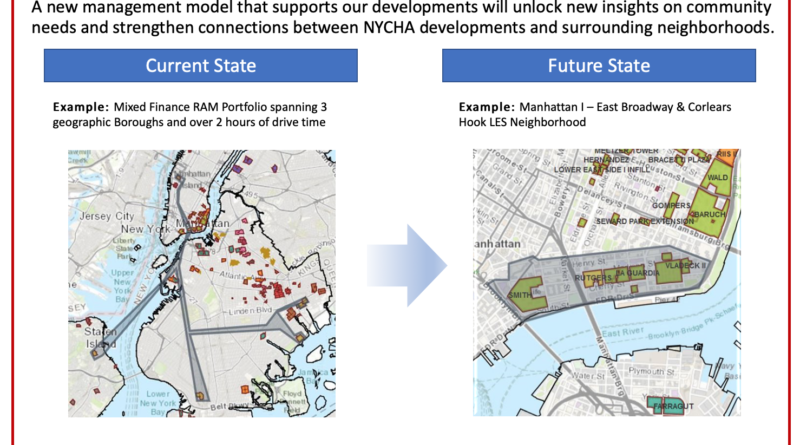NYCHA’s Neighborhood Model Restructures Operations to Improve Service Delivery
NYCHA is improving service to residents through its Blueprint for Change Transformation Plan.
A key initiative of this Transformation Plan is a restructuring of the Authority’s property management operations known as the Neighborhood Model. Through this model, NYCHA aims to address various operational challenges that arise as a result of the large scale of the organization, which manages nearly 173,000 apartments in 316 developments across the city’s five boroughs.
The new Neighborhood Model seeks to improve oversight and provide increased attention to NYCHA developments by creating smaller property management portfolios.
“This Neighborhood Model is so key to everything else that we’re planning,” said Eva Trimble, the Authority’s Executive Vice President for Strategy and Innovation. “When we look at NYCHA and how big it is, we really need to restructure the scale of NYCHA, down to the smaller units, so that we can increase management oversight and supervision in order to improve service delivery.”
The Authority’s property management operations were previously divided into six borough structures, including the four geographic boroughs of Manhattan, the Bronx, Brooklyn, and Queens/Staten Island, as well as the two “functional” boroughs of Mixed Finance and NextGeneration Operations (NGO). The six boroughs were led by up to three vice presidents and a total of 21 regional asset managers (RAM), who each oversaw approximately 8,000 apartments in their portfolio.
Under the new model, the six operational structures will be broken down into the four geographic boroughs, each led by a vice president. The total number of regional asset managers – who will now be known as neighborhood administrators – will increase from 21 to 30, representing 30 portfolio “neighborhoods” across the city, each with 4,000 to 7,000 apartments in their area. Property managers at each NYCHA development will now report to a neighborhood administrator.
According to Ms. Trimble, the Neighborhood Model “changes NYCHA’s entire property management operations by changing the portfolio of how our developments are put together.”
Prior to rolling out the Neighborhood Model initiative in February, NYCHA held virtual meetings with the new vice presidents and resident leaders from each of the four geographic boroughs to discuss the changes in property management operations and answer questions. The vice presidents include Marvin Walton in Manhattan, Joseph Courtien in Brooklyn, Angela Gadson-Floyd in the Bronx, and Wanjiru Bila in Queens/Staten Island.
This fundamental change in operational structure will enable NYCHA to have a deeper understanding of its developments’ needs and challenges, which the Authority will be able to address with tailored solutions and better allocation of resources. NYCHA will also be able to tackle such challenges more quickly, as key decision making will be moved closer to the front lines.
With vice presidents based in their respective boroughs and neighborhood administrators serving smaller neighborhood portfolios, the administrators will have the opportunity to learn the unique needs of their developments and spend more time at the sites, while also providing improved accountability and more “eyes on the buildings.”
“This is going to increase accountability, because now we’re going to have people actually on the ground at all levels and everyone will be held accountable and responsible,” noted Mr. Walton, Vice President of Operations in Manhattan.
Ms. Trimble added, “This plan helps create smaller portfolios so (the administrators) can be more on the ground with more eyes to see what’s going on and provide the property managers more support on a day-to-day basis.”
Under the former six-borough structure, the regional asset managers had a much larger portfolio area to oversee, with some properties located much further apart from each other in different boroughs, requiring longer travel times between sites. The new Neighborhood Model will cut down on travel times for neighborhood administrators by reducing the size of their respective portfolio, with properties located closer to each other. In Manhattan, for example, Mr. Walton said the borough will now be represented by nine neighborhood administrators, compared with only four RAMs previously.
The Transformation Plan’s Neighborhood Model is intended to increase connectivity among developments, residents, and existing neighborhood and community networks. Over time, this revamped organizational structure is expected to lead to improvements in how the Authority resolves work orders, maintains developments, and delivers services to residents.
“It’s a new day at NYCHA now, in terms of our structure,” Mr. Walton said.
Photo caption: The new Neighborhood Model has divided NYCHA’s property management operations into 30 portfolio “neighborhoods” across the city, each consisting of 4,000 to 7,000 apartments.

